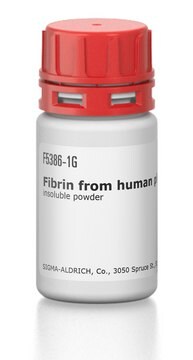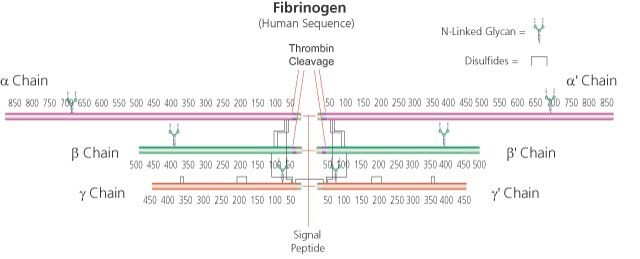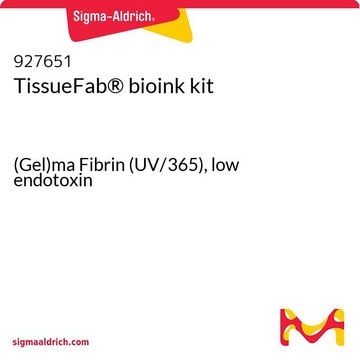927074
TissueFab® bioink kit
(Gel)ma Fibrin (Vis/405), low endotoxin
Synonim(y):
Fibryna, Fibrynogen, GelMA, Metakrylamid żelatyny, Metakrylan żelatyny, Metakryloil żelatyny, Trombina
About This Item
Polecane produkty
Poziom jakości
Formularz
(Solid chunks, fibers or powder)
zanieczyszczenia
<10 CFU/g Bioburden (Fungal)
<10 CFU/g Bioburden (Total Aerobic)
<125 EU/g Endotoxin
kolor
, Pale white to colorless
Zastosowanie
3D bioprinting
temp. przechowywania
2-8°C
Szukasz podobnych produktów? Odwiedź Przewodnik dotyczący porównywania produktów
Powiązane kategorie
Opis ogólny
Protokół można znaleźć w sekcji "Więcej dokumentów" na dole strony.
TissueFab® bioink kit- (Gel)ma Fibrin (Vis/405), low endotoxin zawiera:
2- 500 mg liofilizowanych składników tuszu
1- liofilizowana trombina w proszku
1- 10 ml buforu HEPES.
Metakryloil żelatyny (GelMA) jest polimeryzowalnym materiałem hydrożelowym pochodzącym z naturalnych składników macierzy pozakomórkowej (ECM). Ze względu na niski koszt, obfitość i zachowanie naturalnych motywów wiążących komórki, żelatyna stała się bardzo poszukiwanym materiałem do zastosowań w inżynierii tkankowej. Fibrynogen jest rozpuszczalną glikoproteiną wytwarzaną przez wątrobę. Może być emzymatycznie polimeryzowany do monomerów fibryny przez trombinę, a następnie do skrzepu krwi na bazie fibryny podczas krzepnięcia krwi. Dzięki wielu miejscom wiążącym komórki, takim jak RGD (Arg-Gly-Asp), fibryna odgrywa ważną rolę w interakcji komórka-matryca, może promować adhezję, proliferację i migrację komórek.
Zastosowanie
Cechy i korzyści
Niska zawartość endotoksyn, niskie obciążenie biologiczne: Wykazano, że endotoksyny mają negatywny wpływ na wzrost komórek, morfologię, różnicowanie, stan zapalny i ekspresję białek. Obciążenie biologiczne definiuje się jako liczbę skażonych organizmów znalezionych w danej ilości materiału. Testujemy każdą partię pod kątem endotoksyn, a także całkowitego obciążenia biologicznego (tlenowego i grzybiczego), aby zminimalizować niepożądane interakcje. Więcej informacji: https://www.sigmaaldrich.com/US/en/technical-documents/technical-article/microbiological-testing/pyrogen-testing/what-is-endotoxin
Informacje prawne
produkt powiązany
Hasło ostrzegawcze
Danger
Zwroty wskazujące rodzaj zagrożenia
Zwroty wskazujące środki ostrożności
Klasyfikacja zagrożeń
Eye Irrit. 2 - Resp. Sens. 1 - Skin Irrit. 2 - STOT SE 3
Organy docelowe
Respiratory system
Kod klasy składowania
10 - Combustible liquids
Wybierz jedną z najnowszych wersji:
Certyfikaty analizy (CoA)
It looks like we've run into a problem, but you can still download Certificates of Analysis from our Dokumenty section.
Proszę o kontakt, jeśli potrzebna jest pomoc Obsługa Klienta
Masz już ten produkt?
Dokumenty związane z niedawno zakupionymi produktami zostały zamieszczone w Bibliotece dokumentów.
Nasz zespół naukowców ma doświadczenie we wszystkich obszarach badań, w tym w naukach przyrodniczych, materiałoznawstwie, syntezie chemicznej, chromatografii, analityce i wielu innych dziedzinach.
Skontaktuj się z zespołem ds. pomocy technicznej










